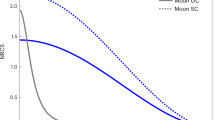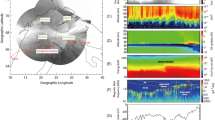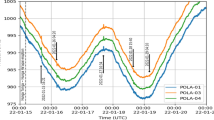Abstract
In 1982 a new radar auroral backscatter system, SABRE (Sweden and Britain Radar Experiment), commenced operation in northern Europe. Observations with this ground-based system allow estimates to be made of the electric fields in the auroral E-region. As an electric field probe, the coherent radar technique is unique in that measurements are made over a large area (∼200,000 km2) with good spatial resolution (20 × 20 km2) and with a temporal resolution of typically 20 s. The system field of view covers an L-value range 4.3–5.8. This region in the magnetosphere–ionosphere system is now accessible for the first time for detailed electric field studies. We present here observations of two pulsation events.
This is a preview of subscription content, access via your institution
Access options
Subscribe to this journal
Receive 51 print issues and online access
$199.00 per year
only $3.90 per issue
Buy this article
- Purchase on Springer Link
- Instant access to full article PDF
Prices may be subject to local taxes which are calculated during checkout
Similar content being viewed by others
References
Sudan, R. N., Akinrimisi, J. & Farley, D. T. J. geophys. Res. 7, 240–248 (1973).
Nielsen, E. & Whitehead, J. D. Proc. COSPAR, Ottawa (in the press).
Schlegel, K. Radio Sci. (in the press).
Schlegel, K. & St-Maurice, J. P. J. geophys. Res. 86, 1447–1452 (1981).
St-Maurice, J. P., Schlegel, K. & Banks, P. M. J. geophys. Res. 86, 1453–1462 (1981).
Nielsen, E. & Schlegel, K. J. geophys. Res. (in the press).
Greenwald, R. A., Weiss, W., Nielsen, E. & Thomson, N. Radio Sci. 13, 1021–1039 (1978).
Redfern, J. Nature 290, 727 (1981).
Rummler, W. D. MM-68-4121-15 (Bell Telephone Laboratory, New York, 1968).
Walker, A. D. M., Greenwald, R. A., Stuart, W. F. & Green, C. A. J. geophys. Res. 84, 3373 (1979).
Poulter, E. M. J. geophys. Res. 87, 8167–8173 (1982).
Poulter, E. M., Nielsen, E. & Potemra, T. J. geophys. Res. 87, 2331–2336 (1982).
Nielsen, E. & Allan, W. J. geophys. Res. (in the press).
Allan, W. & Knox, F. B. Planet. Space Sci. 27, 79–85 (1979).
Allan, W. & Knox, F. B. Planet. Space Sci. 27, 939–950 (1979).
Spiro, R. W., Reiff, P. H. & Maher, L. J. Jr J. geophys. Res. 87, 8215–8227 (1982).
Wallis, D. D. & Budzinski, E. E. J. geophys. Res. 86, 125–137 (1982).
Allan, W., Poulter, E. M. & Nielsen, E. J. geophys. Res. 87, 6163–6172 (1982).
Nielsen, E. The IMS Source Book (eds Russell, C. T. & Southwood, D. J.) 213–224 (American Geophysical Union, Washington, DC, 1982).
Author information
Authors and Affiliations
Rights and permissions
About this article
Cite this article
Nielsen, E., Güttler, W., Thomas, E. et al. A new radar auroral backscatter experiment. Nature 304, 712–714 (1983). https://doi.org/10.1038/304712a0
Received:
Accepted:
Published:
Issue Date:
DOI: https://doi.org/10.1038/304712a0
This article is cited by
-
A decade of the Super Dual Auroral Radar Network (SuperDARN): scientific achievements, new techniques and future directions
Surveys in Geophysics (2007)
-
DARN/SuperDARN
Space Science Reviews (1995)
-
International solar terrestrial energy programme and the UK participation
Surveys in Geophysics (1993)
-
Joint STARE and SABRE radar auroral observations of the high-latitude ionospheric convection pattern
Nature (1985)
-
Mean auroral E-region plasma convection patterns measured by SABRE
Nature (1985)
Comments
By submitting a comment you agree to abide by our Terms and Community Guidelines. If you find something abusive or that does not comply with our terms or guidelines please flag it as inappropriate.



